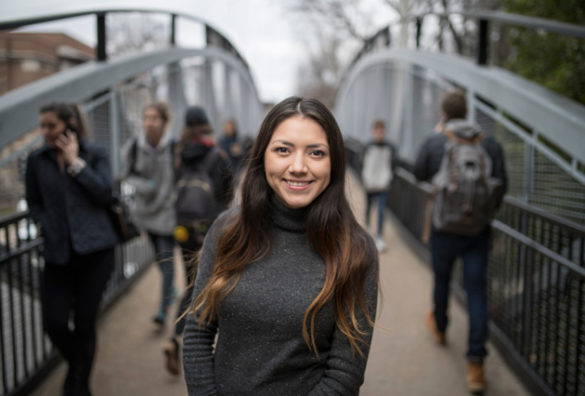by Pamela Coyle
Growing up outside Houston, Paloma Mendoza did not know a single engineer, though she knew she wanted to be one.
Mendoza used summer programs at other universities to test her interests. Business, no thank you. Engineering, yes. Civil engineering, yes, please! A program with the Architects and Civil Engineers Association that put high school students together with professional architects, builders and civil engineers clinched it.
Mendoza’s adviser at her YES Prep charter high school recommended Vanderbilt, which already had a relationship with the school. Once here, it did not take Mendoza, a civil engineering major, long to dive into the real-world applications of her chosen field.
With B.L. Harbert International, she interned under the project manager overseeing construction of a new college dormitory in Nashville. With Hensen Phelps, she interned on a terminal expansion project at the Austin, Texas, airport. As her senior year closes, Mendoza is working at T Square Engineering. The Brentwood, Tennessee, firm specializes in transportation planning, traffic engineering, and land planning and zoning in addition to brick-and-mortar civil engineering.

Land development and transportation design is where Mendoza wants to take her career. But first she helped design a bridge.
For their senior project, Mendoza and two other students designed a pedestrian bridge for residents in the Agalta Valley of Honduras. For residents of the village of Esteban, schools, clinics and some jobs are four hours away by foot when the Rio Grande reaches high water levels.
“[rquote]Helping someone even if I never meet them—that is what drew me to it,”[/rquote] she said.
Mendoza’s Vanderbilt teammates traveled to the site to get soil samples and work out preliminary specs. Once back in Nashville, the team worked with professional engineers to make sure their ideas would fly.
Each week they set deadlines for themselves, spending four or more hours at a time on calculations. That project, along with other Vanderbilt experiences, reinforced the importance of working as part of a team or larger group.
“That’s especially hard for people who want to be leaders, and Vanderbilt students have intrinsic leadership traits,” said Mendoza, who makes a point to reach out to new students arriving at Vanderbilt from YES Prep.
As for the 165-foot-long bridge, it will be completed in 2018 by project partner Honduras Outreach Inc., a nonprofit organization.